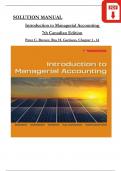Exam (elaborations)
Solution Manual Introduction to Managerial Accounting, 7th Edition Brewer/Garrison, Complete Chapters 1 to 14, Verified Latest Version
- Course
- Institution
Brewer/Garrison, Introduction to Managerial Accounting, 7th Edition, SOLUTION MANUAL, Complete Chapters 1 - 14, Verified Latest Version Brewer/Garrison, Introduction to Managerial Accounting, 7th Edition, SOLUTION MANUAL, Complete Chapters 1 - 14, Verified Latest Version Introduction to Managerial ...
[Show more]



